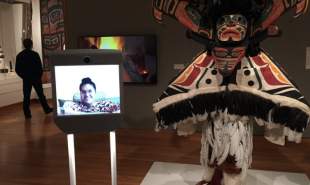
While most museums make a big effort to make their spaces accessible to as many people as possible, countless citizens are still unable to visit because of poor health or disabilities. Now, a roaming video device called Beam — developed by Suitable Technologies — could enable people to explore the exhibits in museums and galleries remotely.
Beam is a moving telepresence device which can be controlled remotely via desktop. The robot is equipped with a wide angle camera at approximately eye level and another facing the ground, to help the pilot navigate the space. The camera has a 3x zoom, but the developers are looking to expand this to a 10x zoom which will enable users to read labels and experience close-up views of artworks. The Beam also features a screen which displays the face of the user, giving them a visual and potential audio presence at the gallery.

We saw a similar device used by London’s Tate Modern during their After Dark project, which enabled uses to browse the gallery’s collection after closing time using a similar telepresence robot. Beams are currently available to buy but cannot be used by the public in museums yet as a number of upgrades and adjustments are necessary — including geofencing, which would prevent the robots from getting too close to the artworks. For now, Suitable Technologies is working with a number of US galleries including Detroit Institute of Arts, Seattle Art Museum and San Francisco’s Fine Art Museum, to perfect the device.
How else could Beams be improved to enhance the experience of disabled art lovers?
Website: www.suitabletech.com
Contact: info@suitabletech.com




